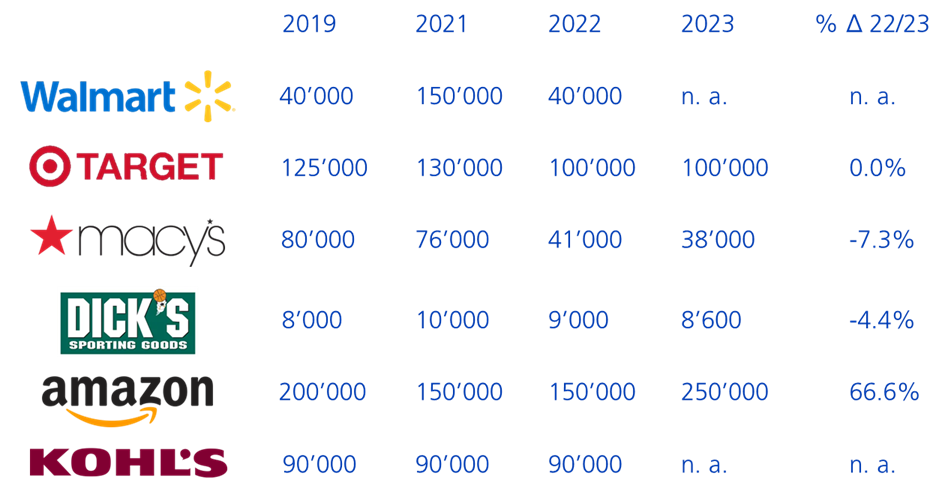Holiday season: Shoppers' mood is restrained
With Black Friday, the "Super Shopping Month" has reached a peak. Although initial calculations suggest stable sales figures in China, the weakening global economy, geopolitical tensions and increased uncertainty about future prospects are dampening consumer sentiment. Nevertheless, there are investment opportunities.

Singles Day on November 11 marks the start of "Super Shopping Month". The most important shopping days in the Christmas season are Black Friday on November 24 and Cyber Monday on November 27, which continue to be heavily used by consumers.
It is no wonder that they are less willing to spend than in previous years due to persistently high inflation, geopolitical conflicts and - since this October - the repayment of student loans.
The importance of the "Super Shopping Months" is also evident in the latest survey conducted by Morgan Stanley AlphaWise Research in October 2023 (see chart): In the survey, 59% of respondents stated that they will do their Christmasshopping by the end of November. Almost 40% of consumers plan to wait until the end of November to do the majority of their Christmas shopping in order to take advantage of the Black Friday and Cyber Monday offers.
Black Friday and Cyber Monday - the most important shopping days in the US Christmas season

China: More robust than expected
The 15th Singles Day Festival, also known as "Double 11", recently came to an end in China. Initial calculations of the sales figures are more robust than expected. A total of RMB 1'138.6 billion worth of goods were sold between October 31 and November 11. This currently corresponds to around CHF 143.5 billion and growth of around 2.1% compared to the previous year.
It was striking that the motto of the e-commerce platforms on this year's Singles Day was "Low prices" or "Really cheap". In the current economic situation, which is characterized by a structural slowdown in growth and increasing consumer restraint, the search for a very attractive offer seems to be gaining in importance. This is reflected in the fact that although parcel deliveries have increased by 23% year-on-year in the same period, the value per order is lower due to high discounts. The focus on lower prices and everyday consumer categories will continue to put pressure on the margins of manufacturers and retailers.
Lower growth than 2022
The National Retail Federation (NRF) is forecasting sales growth of around 3 to 4% this year. This corresponds to the annual average between 2010 and 2019. However, growth is significantly lower compared to the record years of 2020 to 2022. The trend is similar to 2022, when sales growth of 5.4% was significantly below the 2021 figure of 12.7%, but above the pre-coronavirus level. In view of the current US inflation rate of 3.2%, the forecast sales growth is not significantly higher. This year, an average of around USD 875 will be spent on gifts, decorations, food and other Christmas-related purchases - slightly more than in the past ten years.
In addition, the warm and humid weather so far is dampening the mood in the retail sector. This is forcing retailers to offer higher discounts on winter clothing in order to avoid overstocking. Lower demand for winter clothing and accessories could exacerbate an already difficult Christmas season due to uncertain consumer spending.
Fewer seasonal workers in the retail trade in the USA
US retailers are planning to hire around 553'000 seasonal workers this season, according to data from the industry newspaper "Retail Dive". This corresponds to a decrease of almost 46'000 compared to the previous year and around 140'000 compared to 2021. The decline in seasonal workers primarily affects brick-and-mortar retailers in the USA. In contrast, Amazon plans to hire 250'000 seasonal workers, which corresponds to an increase of 66.6% compared to the previous year.
Number of seasonal employees at US retailers since 2019

What is striking is that a comparison with 2019, the Christmas before the pandemic, shows that some retailers have hired significantly fewer seasonal workers. Walmart and Kohl's have not yet provided any information.
Investment opportunities still exist
In the current consumer environment, price-oriented retailers such as Walmart and Target, online giant Amazon.com and discount retailers such as TJX and Ross could be better positioned for the holiday shopping season. In addition, the current environment is likely to lead to more promotions relative to 2021 and 2022, with large discounts likely to increase footfall and boost sales in key categories such as electronics, toys and apparel. However, higher promotions will have a negative impact on profit margins, which will continue to be of key importance for retailers in 2023 given the ongoing pressure on demand.
| Name | 2yr - Forward ROIC | Enterprise Value / Invested Capital | ZKB ESG Score (A-G) |
| Target | 13,6% | 1,9x | C |
| Walmart | 14,7% | 3,4x | D |
| Koninklijke Ahold | 8,9% | 1,2x | B |
| Name | 2yr - Forward ROIC | Enterprise Value / Invested Capital | ZKB ESG Score (A-G) |
| TJX | 26,3% | 5,9x | C |
| Ross Stores | 19,7% | 4,1x | D |
| Burlington Stores | 10,5% | 2,2x | C |
| Name | 2yr - Forward ROIC | Enterprise Value / Invested Capital | ZKB ESG Score (A-G) |
| Amazon | 16,0% | 4,9x | D |
| Etsy | 22,7% | 4,8x | C |
The securities in the table were selected according to our quality analysis. Among other things, this takes into account the business model and the associated prospect of an attractive total return on invested capital (ROIC).
Legal notice: The publications were prepared by the Buy-Side Research of the Asset Management of Zürcher Kantonalbank. The information contained in this document has not been prepared in accordance with any legislation promoting the independence of financial research, nor is it subject to any prohibition on trading following the dissemination of financial research.
